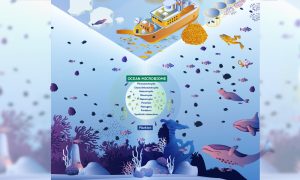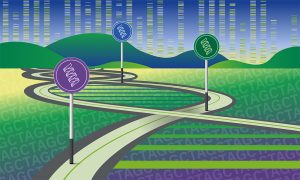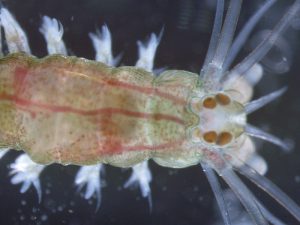
Shedding light on rare diseases: open data and model organisms
Why open data from model organisms is essential for rare disease research.
2023
perspectivesscience

Why open data from model organisms is essential for rare disease research.
2023
perspectivesscience

Jo McEntyre talks about data services, open data and a new era for research assessment.
LAB MATTERSPEOPLE & PERSPECTIVES2023
lab-matterspeople-perspectivesperspectives

Microbial communities play essential roles in ocean ecology and planetary health. A recent publication highlights priorities for understanding and protecting ocean microbiomes.
SCIENCE & TECHNOLOGY2022
sciencescience-technology

Scientists identify previously unexplored gene segments to be added to human genome databases.
SCIENCE & TECHNOLOGY2022
research-highlightssciencescience-technology

EMBO Director Fiona Watt discusses preprints, data sharing, and evaluation in light of EMBL’s new Open Science policy
LAB MATTERSPEOPLE & PERSPECTIVES2022
lab-matterspeople-perspectives
Microscope designer Leica Microsystems and the European Molecular Biology Laboratory (EMBL) signed a corporate partnership agreement today whereby Leica Microsystems becomes a founder partner of the EMBL Advanced Training Centre scheduled to be completed in September 2009. Besides its financial…
LAB MATTERS2008
lab-matters
Cell division is one of the most fundamental processes of life. It explains how one cell can give rise to an organism of several million cells, it determines the shape of different life forms and it underpins our body’s capacity to heal when injured. Often we only notice how important cell…
SCIENCE & TECHNOLOGY2008
sciencescience-technology
The European Molecular Biology Laboratory (EMBL) and PerkinElmer Life and Analytical Sciences, a global leader in life science research, drug discovery and cellular science, today announced that they have entered into a corporate partnership in support of EMBL’s Advanced Training Centre in…
LAB MATTERS2008
lab-matters

The best-selling novel The swarm captured the imagination of countless readers with the fascination of marine life. But it also showed how little we understand life in the depth of the ocean. Scientists at the European Molecular Biology Laboratory (EMBL) and the Max Planck Institute (MPI)…
SCIENCE & TECHNOLOGY2008
sciencescience-technology
What at the first sight could be pictures of planets or other cosmic structures are actually microscope images of balls (cysts) of human kidney cells. They were taken by Emmanuel Reynaud, in the group of Ernst Stelzer at the European Molecular Biology Laboratory (EMBL), with a widefield microscope.…
SCIENCE & TECHNOLOGY2008
sciencescience-technology
Today at a meeting organised by the European Molecular Biology Laboratory (EMBL) in Heidelberg, Germany, scientists from around the globe announced the formation of the International Human Microbiome Consortium (IHMC), an effort that will enable researchers to characterise the relationship of the…
LAB MATTERS2008
lab-matters
Researchers at the European Molecular Biology Laboratory (EMBL) have generated a digital zebrafish embryo – the first complete developmental blueprint of a vertebrate. With a newly developed microscope scientists could for the first time track all cells for the first 24 hours in the life of a…
SCIENCE & TECHNOLOGY2008
sciencescience-technology
The Wellcome Trust has awarded £4.7 million (€5.8 million) to EMBL’s European Bioinformatics Institute (EMBL-EBI) to support the transfer of a large collection of information on the properties and activities of drugs and a large set of drug-like small molecules from the publicly listed…
LAB MATTERS2008
lab-matters
Mouse mothers-to-be have a remarkable way to protect their unborn pups. Because the smell of a strange male’s urine can cause miscarriage and reactivate the ovulatory cycle, pregnant mice prevent the action of such olfactory stimuli by blocking their smell. Researchers from the European…
SCIENCE & TECHNOLOGY2008
sciencescience-technology
Researchers from the European Molecular Biology Laboratory (EMBL) discovered a new way to make use of drugs’ unwanted side effects. They developed a computational method that compares how similar the side effects of different drugs are and predicts how likely the drugs act on the same target…
SCIENCE & TECHNOLOGY2008
sciencescience-technology
Genetic recombination, the process by which sexually reproducing organisms shuffle their genetic material when producing germ cells, leads to offspring with a new genetic make-up and influences the course of evolution. In the current issue of Nature, researchers at the European Molecular…
SCIENCE & TECHNOLOGY2008
sciencescience-technology
Sudden Infant Death Syndrome (SIDS) is a condition that unexpectedly and unexplainably takes the lives of seemingly healthy babies aged between a month and a year. Now researchers of the European Molecular Biology Laboratory in Monterotondo, Italy, have developed a mouse model of the so-called crib…
SCIENCE & TECHNOLOGY2008
sciencescience-technology
What makes a human different from a chimp? Researchers from the European Molecular Biology Laboratory’s European Bioinformatics Institute (EMBL-EBI) have come one important step closer to answering such evolutionary questions correctly. In the current issue of Science they uncover…
SCIENCE & TECHNOLOGY2008
sciencescience-technology
Researchers from the European Molecular Biology Laboratory (EMBL) in Heidelberg, Germany, and the EMBL-European Bioinformatics Institute (EMBL-EBI) in Hinxton, UK, have revealed new insights into how sex chromosomes are regulated. A chromatin modifying enzyme helps compensate for the fact that…
SCIENCE & TECHNOLOGY2008
sciencescience-technology
In a contract signed today, the European Commission has awarded €4.5 million to a pan-European consortium to decide upon the best way to unite Europe’s biological data resources into a sustainable, integrative bioinformatics network for the life sciences. The European Life-science…
LAB MATTERS2008
lab-matters
UK-based researchers at the Medical Research Council Functional Genomics Unit in Oxford and the European Molecular Biology Laboratory’s European Bioinformatics Institute in Cambridge have revealed the genetic makeup of the one of the world’s strangest mammals. They have analysed the DNA…
SCIENCE & TECHNOLOGY2008
sciencescience-technology
Influenza is currently a grave concern for governments and health organisations around the world. Now one of the tactics used by influenza virus to take over the machinery of infected cells has been laid bare by structural biologists at the EMBL, the joint Unit of Virus Host-Cell Interaction of…
SCIENCE & TECHNOLOGY2008
sciencescience-technology
Leukaemia – cancer of blood or bone marrow – is caused by mutations that allow defective blood cells to accumulate and displace healthy blood. To devise effective therapies it is crucial to know which mutations cause leukaemia and which cell type gives rise to leukaemic cells. Researchers from…
SCIENCE & TECHNOLOGY2008
sciencescience-technology
Epigenetic regulation – modifications to the structure of chromatin that influence which genes are expressed in a cell – is a key player in embryonic development and cancer formation. Researchers at the European Molecular Biology Laboratory (EMBL) in Heidelberg now gained new insight…
SCIENCE & TECHNOLOGY2008
sciencescience-technology
Much less widely known than the dangerous consequences of iron deficiencies is the fact that too much iron can also cause problems. The exact origin of the genetic iron overload disorder hereditary hemochromatosis [HH] has remained elusive. In a joint effort, researchers from the European Molecular…
SCIENCE & TECHNOLOGY2008
sciencescience-technology
Drawing on the expertise of multi-disciplinary research teams, the map developed by the 1000 Genomes Project will provide a view of biomedically relevant DNA variations at a resolution unmatched by current resources. The European Bioinformatics Institute (EBI), working with long-term collaborator…
LAB MATTERS2008
lab-matters
Researchers from the European Molecular Biology Laboratory (EMBL) have discovered that proteins that regulate the body’s iron household play a vital role in making sure enough nutrients and water are absorbed in the intestine. Mice lacking these proteins suffer from weight loss and…
SCIENCE & TECHNOLOGY2008
sciencescience-technology
No matching posts found